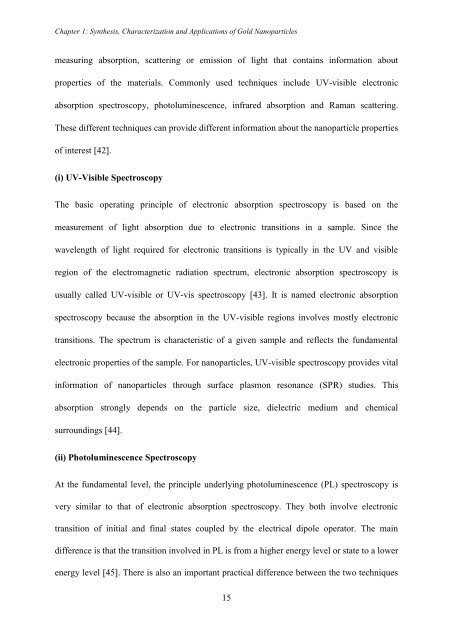PHYS01200704032 Debes Ray - Homi Bhabha National Institute
PHYS01200704032 Debes Ray - Homi Bhabha National Institute
PHYS01200704032 Debes Ray - Homi Bhabha National Institute
You also want an ePaper? Increase the reach of your titles
YUMPU automatically turns print PDFs into web optimized ePapers that Google loves.
Chapter 1: Synthesis, Characterization and Applications of Gold Nanoparticles<br />
measuring absorption, scattering or emission of light that contains information about<br />
properties of the materials. Commonly used techniques include UV-visible electronic<br />
absorption spectroscopy, photoluminescence, infrared absorption and Raman scattering.<br />
These different techniques can provide different information about the nanoparticle properties<br />
of interest [42].<br />
(i) UV-Visible Spectroscopy<br />
The basic operating principle of electronic absorption spectroscopy is based on the<br />
measurement of light absorption due to electronic transitions in a sample. Since the<br />
wavelength of light required for electronic transitions is typically in the UV and visible<br />
region of the electromagnetic radiation spectrum, electronic absorption spectroscopy is<br />
usually called UV-visible or UV-vis spectroscopy [43]. It is named electronic absorption<br />
spectroscopy because the absorption in the UV-visible regions involves mostly electronic<br />
transitions. The spectrum is characteristic of a given sample and reflects the fundamental<br />
electronic properties of the sample. For nanoparticles, UV-visible spectroscopy provides vital<br />
information of nanoparticles through surface plasmon resonance (SPR) studies. This<br />
absorption strongly depends on the particle size, dielectric medium and chemical<br />
surroundings [44].<br />
(ii) Photoluminescence Spectroscopy<br />
At the fundamental level, the principle underlying photoluminescence (PL) spectroscopy is<br />
very similar to that of electronic absorption spectroscopy. They both involve electronic<br />
transition of initial and final states coupled by the electrical dipole operator. The main<br />
difference is that the transition involved in PL is from a higher energy level or state to a lower<br />
energy level [45]. There is also an important practical difference between the two techniques<br />
15

















